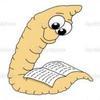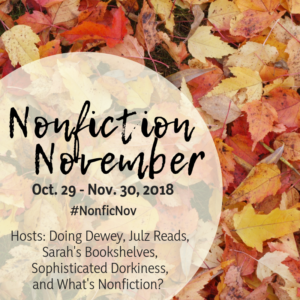
Hello everyone and welcome to a very exciting month ahead – Nonfiction November! I really wanted to take part in this last year but had so many commitments for review copies that I just couldn’t fit it in but this year I’m determined. I still have a few ARC’s to read in November so I won’t be reading solely non-fiction but I’m hoping the majority of my reading will fall into that genre.
First, a little bit about Nonfiction November – it’s hosted by Katie of Doing Dewey, Kim of Sophisticated Dorkiness, Rennie of What’s Nonfiction, Julz of JulzReads, and Sarah of Sarah’s Bookshelves. Each week of the month there will be a discussion question and link up related to non-fiction on one of the host’s blogs above and I can’t wait to join in! There is also an Instagram challenge going on starting today with various prompts for each day of the month and I’m going to attempt to join in with as many as I can (bibliobeth on Instagram if you fancy giving me a follow). I can’t promise the world’s most beautiful pictures but I can promise some interesting non-fiction recommendations for sure! The Instagram challenge is co-hosted by Kim (@kimthedork) and Leann (@Shelf_Aware_). and if you’d like to join in, they’d love to see your pictures using the hashtag #NonficNov.
But back to today’s post. I thought that today I’d talk about my Nonfiction November TBR or what I HOPE to be getting to this month. I’ve chosen eight books, which is quite optimistic considering the other fiction books I’ve promised to read so perhaps I won’t get to all of these but I’m going to give it a good go. Any that I don’t read will be read soon enough as I often read a non-fiction book alongside my current fiction read and an old favorite.
Here we go!
1.) The Diary Of A Bookseller – Shaun Bythell
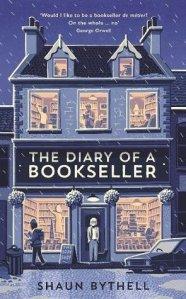
What’s it all about?:
Shaun Bythell owns The Bookshop, Wigtown – Scotland’s largest second-hand bookshop. It contains 100,000 books, spread over a mile of shelving, with twisting corridors and roaring fires, and all set in a beautiful, rural town by the edge of the sea. A book-lover’s paradise? Well, almost … In these wry and hilarious diaries, Shaun provides an inside look at the trials and tribulations of life in the book trade, from struggles with eccentric customers to wrangles with his own staff, who include the ski-suit-wearing, bin-foraging Nicky. He takes us with him on buying trips to old estates and auction houses, recommends books (both lost classics and new discoveries), introduces us to the thrill of the unexpected find, and evokes the rhythms and charms of small-town life, always with a sharp and sympathetic eye.
Why do I want to read it?:
I’ve heard SO much about this book and now I just can’t help myself, I have to submit. It sounds cosy, amusing, interesting and is a book about books. What could be better for a bibliophile like myself?
2.) The Education Of A Coroner: Lessons In Investigating Death – John Bateson
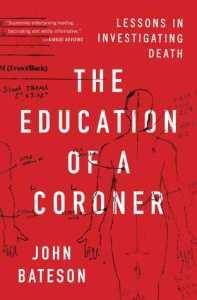
What’s it all about?:
An “entertaining” (Booklist) account of the mysterious, hair-raising, and heartbreaking cases handled by the coroner of Marin County, California throughout his four decades on the job—from high-profile deaths and serial killers to inmate murders and Golden Gate Bridge suicides.
Marin County, California is a study in contradictions. Its natural beauty attracts celebrity residents and thousands of visitors every year, yet the county also is home to San Quentin Prison, one of the oldest and largest penitentiaries in the United States. Marin ranks in the top one percent of counties nationwide in terms of affluence and overall health, yet it is far above the norm in drug overdoses and alcoholism, not to mention the large percentage of suicides that occur on the Golden Gate Bridge.
Ken Holmes worked in the Marin County Coroner’s Office for thirty-six years, starting as a death investigator and ending as the three-term, elected coroner. As he grew into the job—one that is far different from the forensics we see on television—Holmes learned a variety of skills, from finding hidden clues at death scenes, interviewing witnesses effectively, managing bystanders and reporters, and preparing testimony for court to how to notify families of a death with sensitivity and compassion. He also learned about different kinds of firearms, all types of drugs—prescription and illegal—and about certain unexpected and potentially fatal phenomena, such as autoeroticism.
Why do I want to read it?:
This book appeals to the morbid, scientific side of me. I was always intrigued by forensics and this book came up on my recommendations when I bought another book on this Nonfiction November list. Of course as soon as I read the synopsis I couldn’t resist buying it!
3.) The Secret Lives Of Colour – Kassia St. Clair
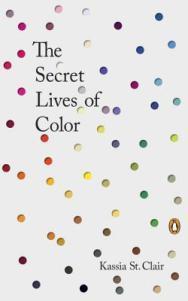
What’s it all about?:
The Secret Lives of Colour tells the unusual stories of seventy-five fascinating shades, dyes and hues. From blonde to ginger, the brown that changed the way battles were fought to the white that protected against the plague, Picasso’s blue period to the charcoal on the cave walls at Lascaux, acid yellow to kelly green, and from scarlet women to imperial purple, these surprising stories run like a bright thread throughout history.
In this book, Kassia St. Clair has turned her lifelong obsession with colours and where they come from (whether Van Gogh’s chrome yellow sunflowers or punk’s fluorescent pink) into a unique study of human civilization. Across fashion and politics, art and war, the secret lives of color tell the vivid story of our culture.
Why do I want to read it?:
This book was taunting me from bookshops for months. I used to always see it as I walked past a particular bookshop in London Waterloo station where it held a very prominent position and I was instantly entranced by the cover. I eventually pre-ordered it in paperback and it’s just as gorgeous, with rainbow coloured pages to illustrate the particular color being talked about. I’m intrigued – particularly with the historical information behind the colours.
4.) Dark Banquet: Blood And The Curious Lives Of Blood-Feeding Creatures – Bill Schutt
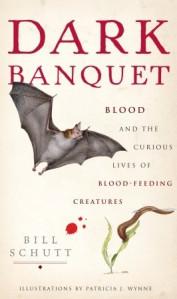
What’s it all about?:
For centuries, blood feeders have inhabited our nightmares and horror stories, as well as the shadowy realms of scientific knowledge. In Dark Banquet, zoologist Bill Schutt takes readers on an entertaining voyage into the world of some of nature’s strangest creatures—the sanguivores. Using a sharp eye and mordant wit, Schutt makes a remarkably persuasive case that vampire bats, leeches, ticks, bed bugs, and other vampires are as deserving of our curiosity as warmer and fuzzier species are—and that many of them are even worthy of conservation.
Schutt takes us from rural Trinidad to the jungles of Brazil to learn about some of the most reviled, misunderstood, and marvelously evolved animals on our planet: vampire bats. Only recently has fact begun to disentangle itself from fiction concerning these remarkable animals, and Schutt delves into the myths and misconceptions surrounding them.
Examining the substance that sustains nature’s vampires, Schutt reveals just how little we actually knew about blood until well into the twentieth century. We revisit George Washington on his deathbed to learn how ideas about blood and the supposedly therapeutic value of bloodletting, first devised by the ancient Egyptians and Greeks, survived into relatively modern times. Schutt also tracks the history of medicinal leech use. Once employed by the tens of millions to drain perceived excesses of blood, today the market for these ancient creatures is booming once again—but for very different reasons.
Among the other blood feeders we meet in these pages are bed bugs, or “ninja insects,” which are making a creepy resurgence in posh hotels and well-kept homes near you. In addition, Dark Banquet details our dangerous and sometimes deadly encounters with ticks, chiggers, and mites (the latter implicated in Colony Collapse Disorder—currently devastating honey bees worldwide). Then there are the truly weird—vampire finches. And if you thought piranha were scary, some people believe that the candiru (or willy fish) is the best reason to avoid swimming in the Amazon.
Enlightening, alarming, and appealing to our delight in the bizarre, Dark Banquet peers into a part of the natural world to which we are, through our blood, inextricably linked.
Why do I want to read it?:
I read Cannibalism: A Perfectly Natural History, Bill Schutt’s second non-fiction book as a buddy read with Stuart from Always Trust In Books and we both thoroughly enjoyed it. As a result, I was determined to read his first book which sounds just as fascinating and of course, Nonfiction November is the perfect time to get down to reading it!
5.) The Trauma Cleaner: One Woman’s Extraordinary Life In Death, Decay & Disaster – Sarah Krasnostein
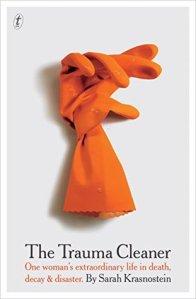
What’s it all about?:
Before she was a trauma cleaner, Sandra Pankhurst was many things: husband and father, drag queen, gender reassignment patient, sex worker, small businesswoman, trophy wife…
But as a little boy, raised in violence and excluded from the family home, she just wanted to belong. Now she believes her clients deserve no less.
A woman who sleeps among garbage she has not put out for forty years. A man who bled quietly to death in his loungeroom. A woman who lives with rats, random debris and terrified delusion. The still life of a home vacated by accidental overdose.
Sarah Krasnostein has watched the extraordinary Sandra Pankhurst bring order and care to these, the living and the dead—and the book she has written is equally extraordinary. Not just the compelling story of a fascinating life among lives of desperation, but an affirmation that, as isolated as we may feel, we are all in this together.
I call my dad from the car and ask him about his morning, tell him about mine.
‘What kind of hoarder was she?’ he asks.
‘Books and cats, mainly,’ I tell the man who loves his cats and who I know is now actively considering his extensive book collection.
‘What’s the difference between a private library and a book hoarder?’ he wonders.
We are both silent before we laugh and answer in unison: ‘Faeces.’
But the difference is this phone call. And the others like it I could make—and how strong we are when we are loved.
Sarah Krasnostein was born in America, studied in Melbourne and has lived and worked in both countries. Earning her doctorate in criminal law, she is a law lecturer and researcher. Her essay, ‘The Secret Life of a Crime Scene Cleaner’, was published on Longreads and listed in Narratively’s Top 10 Stories for 2014. She lives in Melbourne, and spends part of the year working in New York City. The Trauma Cleaner is her first book.
Why do I want to read it?:
The Trauma Cleaner was the book that prompted me to buy The Education Of A Coroner earlier on this list. It’s my fascination with the forensic world again that makes me want to pick up this book but also I like that it has a transgender element which I’m also interested to read and learn more about.
6.) Animals Strike Curious Poses – Elena Passarello
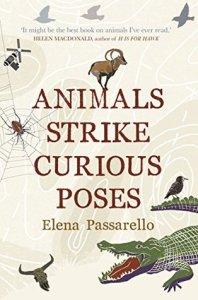
What’s it all about?:
Beginning with Yuka, a 39,000-year-old mummified woolly mammoth recently found in the Siberian permafrost, each of the sixteen essays in Animals Strike Curious Poses investigates a different famous animal named and immortalised by humans. Here are the starling that inspired Mozart with its song, Darwin’s tortoise Harriet, and in an extraordinary essay, Jumbo the elephant (and how they tried to electrocute him). Modelled loosely on a medieval bestiary, these witty , playful, provocative essays traverse history, myth, science and more, introducing a stunning new writer to British readers.
Why do I want to read it?:
Along with science, nature writing (particularly anything that involves animals) is something I love to read about and this book looked too good to pass up. I love that it’s a series of essays and I adore that it follows “famous” animals. I’ve got high hopes for this one!
7.) When Breath Becomes Air – Paul Kalanithi
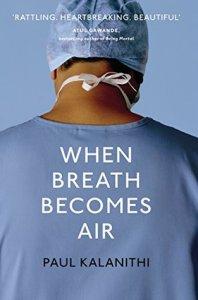
What’s it all about?:
At the age of thirty-six, on the verge of completing a decade’s training as a neurosurgeon, Paul Kalanithi was diagnosed with inoperable lung cancer. One day he was a doctor treating the dying, the next he was a patient struggling to live.
When Breath Becomes Air chronicles Kalanithi’s transformation from a medical student asking what makes a virtuous and meaningful life into a neurosurgeon working in the core of human identity – the brain – and finally into a patient and a new father.
What makes life worth living in the face of death? What do you do when when life is catastrophically interrupted? What does it mean to have a child as your own life fades away?
Paul Kalanithi died while working on this profoundly moving book, yet his words live on as a guide to us all. When Breath Becomes Air is a life-affirming reflection on facing our mortality and on the relationship between doctor and patient, from a gifted writer who became both.
Why do I want to read it?:
Similar to the next book coming up on my Nonfiction November TBR, this is one of the books that has been on my shelves the longest. Everyone keeps telling me how great it is (and I LOVE reading about neurosurgery/the brain) but this one also has a bitter-sweet emotional aspect that I wasn’t sure I was in the right place to read about in the past eighteen months or so. Now however, I am stronger and I am ready! This WILL happen.
8.) Bad Science – Ben Goldacre
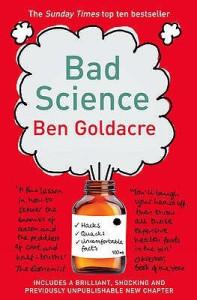
What’s it all about?:
Have you ever wondered how one day the media can assert that alcohol is bad for us and the next unashamedly run a story touting the benefits of daily alcohol consumption? Or how a drug that is pulled off the market for causing heart attacks ever got approved in the first place? How can average readers, who aren’t medical doctors or Ph.D.s in biochemistry, tell what they should be paying attention to and what’s, well, just more bullshit?
Ben Goldacre has made a point of exposing quack doctors and nutritionists, bogus credentialing programs, and biased scientific studies. He has also taken the media to task for its willingness to throw facts and proof out the window. But he’s not here just to tell you what’s wrong. Goldacre is here to teach you how to evaluate placebo effects, double-blind studies, and sample sizes, so that you can recognize bad science when you see it. You’re about to feel a whole lot better.
Why do I want to read it?:
I think this is probably a work of non-fiction that I’ve had the longest. As a scientist in my daily life, I really need to get round to reading this – it’s a travesty I haven’t read it before now!
So, there we have it! My TBR for Nonfiction November has been revealed. What I’d love to hear from you guys is if you’ve read (or want to read) any of these books and what you thought? Let me know if you’re participating in Nonfiction November and what you’ll be reading – links welcome down below in the comments.
COMING UP TOMORROW ON bibliobeth – Nonfiction November Week 1: My Year In Nonfiction.
Advertisements